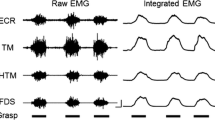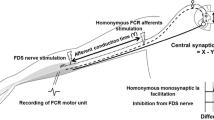Abstract
Adequate stimulation of cutaneous afferents from the fingertip evokes a short-latency inhibition followed by a long-lasting excitation in human flexor carpi radialis (FCR) motoneurones. Changes in excitability of flexor motoneurones were investigated in 11 subjects by means of the H-reflex conditioning technique. The index fingertip, immobilised on a flat table, was stimulated by a small probe mounted on an electromagnetic vibrator. Contact time and tactile perception threshold (PT) were monitored throughout the experiment. In all subjects, tactile stimulation of the skin covering the index pulp, with 10 ms long square pulses, at an intensity of 2–2.5 PT, produced an inhibition starting at a conditioning-test interval of 15 ms and lasting about 2 ms. This was followed by a powerful facilitation lasting more than 10 ms. Excitation appeared just at tactile threshold, whereas threshold for inhibition was about 2 PT. Similar effects were observed after mechanical stimulation of the skin covering the dorsal aspect of the index, close to the nail. Local anaesthesia of the finger pulp drastically reduced both the inhibition and the facilitation of FCR H-reflex. By contrast, electrical stimulation of the index digital nerves, by means of ring electrodes, was always ineffective in modifying the excitability of the FCR H-reflex. It is proposed that inhibition and excitation of FCR H-reflex are caused by activation of oligosynaptic pathways fed by cutaneous afferents; however, it cannot be excluded that joint receptors and primary endings of small hand muscles may contribute in part to the late excitation. The pathways described might play an essential role in modulation and control of exploratory movements and object manipulation, actions that need tactile information to regulate muscle force.
Similar content being viewed by others
Author information
Authors and Affiliations
Additional information
Received: 30 June 1997 / Accepted: 3 November 1997
Rights and permissions
About this article
Cite this article
Cavallari, P., Lalli, S. Changes in excitability of the flexor carpi radialis H-reflex following tactile stimulation of the index fingertip. Exp Brain Res 120, 345–351 (1998). https://doi.org/10.1007/s002210050408
Issue Date:
DOI: https://doi.org/10.1007/s002210050408




